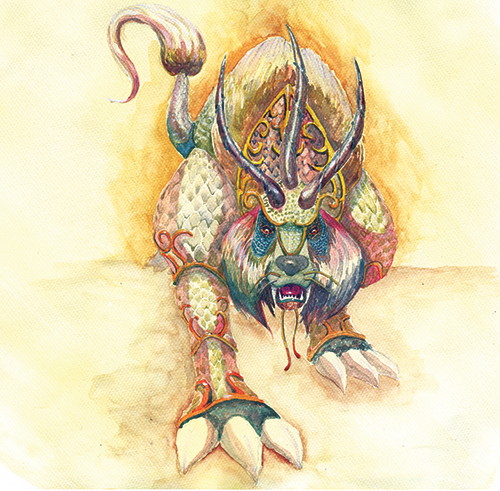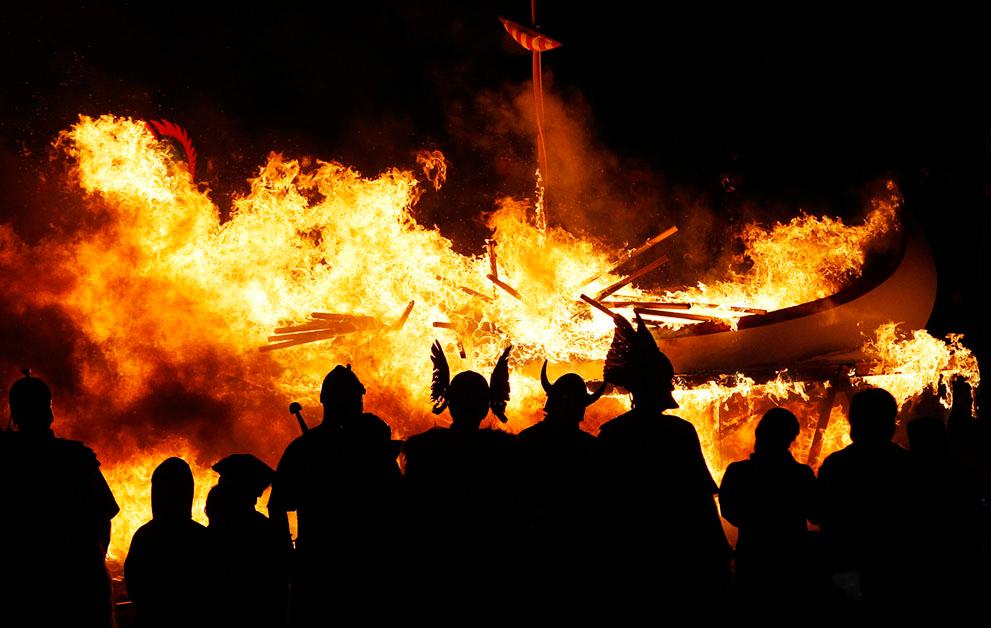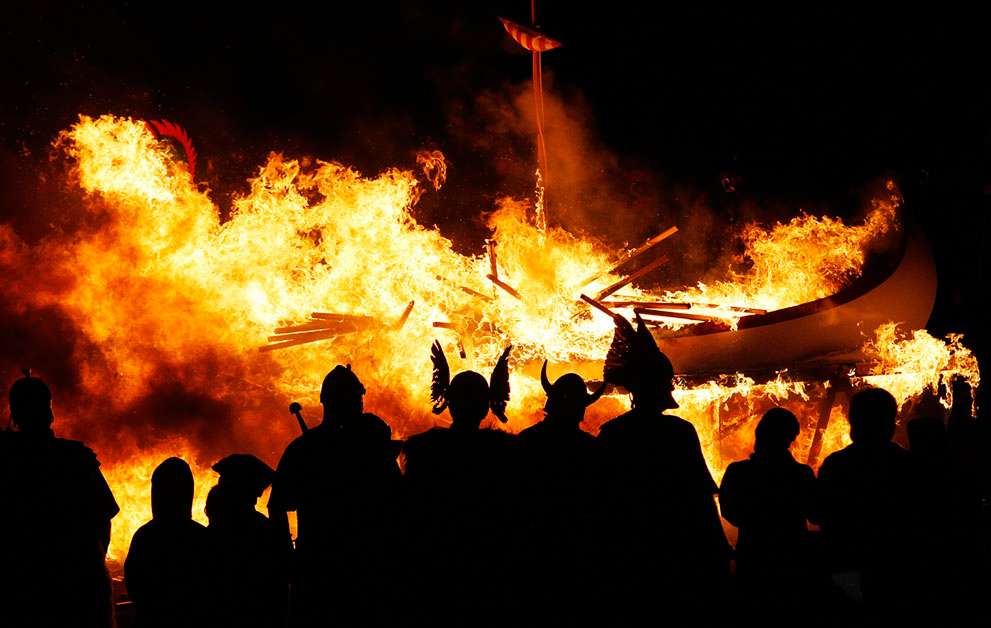Hello everyone. First of all: Happy new year! New year is the beginning of all things fun, exciting and wonderfully traditional. The ancient people rank truth based on whichever story is best relayed over some ale and a folksy campfire, so it’s not surprising that New Year’s Day can involve some of the weirdest tales that you have ever heard.
After all, even the weirdest traditions have a story behind why they happen. Perhaps as fantasy writers, you might feel inspired by the stuff below. But I wrote this article in the New Year spirit. I wish you all the best and remember, new year is the time you spend with your family; not musty self-help articles on writing. Have fun!
The Legend of Nian
Okay, since I was born in China and know enough Chinese to provide context, I am going to help explain this story clearly to the best of my abilities without straight-up plagiarizing from a Chinese government website. The monster’s name translates to Year in English. So keep that in mind as I tell the story.
Imagine you are a stereotypical Chinese farmer returning home from a hard day’s work in the fields. You suspiciously pushed aside the bloodstained door that had been hanging ajar to peer inside. You find your entire family has been killed and a strange beast is eating them.

This is China. What kind of stories did you expect?
A man-eating predatory beast called Nian killed the hypothetical farmer’s family. People tends to have a strange habit of fearing every single thing that is advertised as man-eating. In the story, he got up and killed a lot more people than I would care to mention before people started saying, “We have opposable thumbs! We can rise up against the dark man-eating demon that has been ruling us with our fear of him. We don’t tolerate this in China.”
The beast dwelled deep in the sea the whole year long because…reasons, but on every New Year’s Eve it would climb onto the shore to harm (read: violently kill without remorse) humans in the village. Therefore, on every New Year’s Eve, all the villagers would take their old and young deep into the mountains to hide from Nian. Yes, of course they have a gigantic mountain to hide the old and the young.
One Chinese New Year’s Eve a grey haired man (Gandalf) appeared in the village. He asked permission to stay and assured everyone that he would chase away the beast. It is not recorded whether or not a short Hobbit was nearby muttering about getting sidetracked on their journey to the one ring.
Naturally, since he hasn’t revived in front of the villagers as Gandalf the White (because that’s one way of adding racial undertone to the story), no one believed him. In addition, the old man steadfastly refused to go to the mountains to hide. Seeing that he could not be persuaded, the villagers departed without him, because if he wasn’t going to hide with them, clearly nothing else could be done.
So when the beast Nian arrived at the village to wreck havoc as usual, it was met with a sudden burst of exploding surf that was later known as ‘firecrackers’, since the monster was startled by the noise. The old man (Gandalf) brought about flashes of light and red banners to fly right the hell out of nowhere and scare the living daylights out of the damned beast.
Perhaps it finally realized the complete epic-ness of who he is dealing with, it hastily turned around and fled back into its underwater man cave to sadly weep at itself for obstructing the most powerful wizard-guy from Middle Earth.
The following day, as the people returned from the mountains, they found the village intact and safe. The old man had left (because Middle Earth isn’t going to rescue itself), but they found the remains of the three precious items he had used to chase the beast Nian away. They all agreed that the old man must be a deity who had come to help free them of the beast (close, but we all know the truth, don’t we?).
From then on, every Chinese New Year’s Eve, families would hang red banners, set off firecrackers, and light their lamps the whole night through, awaiting the Chinese New Year. The custom spread far and wide and became a grand traditional celebration of the “Passing of Nian”. So that is why celebrating the Chinese New Year should be called “Passing of Nian” or “Guo Nian” in Chinese. Again, no mentions of a old man wearing all white returning and making epic speeches. But it is possibly a given.
Kissing on New Year’s Eve
Quick! What’s the first western custom that is sort of related to the New Year’s that you can think of? For what I believe as the majority of the English-speaking world, that is going to be the magical kiss at precisely midnight on the New Year’s Eve. At which point both the figurative fireworks and the literal fireworks would be going off.
Historians date this practice back to the Ancient Romans who would throw a big party every New Year’s Eve called the Festival of Saturnalia where they kiss each other in a frantic orgy on that specific moment. Which is probably the beginning of that certain tradition.
But the specific lore behind it didn’t fully develop until well into the more enlightened eras of balls and pompadours. I would say something about powdered wigs, fat people, and makeup, but that would just be me focusing specifically on the British people.
So when masked balls on New Year’s Eve are still a thing, the masks had symbolized the evil spirits and curses that the riches had mysteriously acquired (read: poor people tend to hate it when you get nice things and they don’t.) in the past year and kissing on midnight (after removing the mask; scientists have proven that it is technically impossible to kiss someone with a mask on and not look like a complete douche.) had became an act of purification among the upper class as they scrambled around to finally get some lip action while removing the curses the common folk just happened to know (no mention of an old man approaching them with magic, but it’s assumed).
Source: USA Today
A Traditional Scottish Hogmanay
Right, so Scotland has some weird New Year’s traditions; they have a gloriously long history with the New Year’s Eve (apparently, New Year’s Eve is like Christmas Eve; way more important than the actual event). Did you know that the New Year’s Eve day is called a Hogmanay? Well, the history dates back to the Viking days, and I’ll give a quick reminder to those of you who haven’t covered Vikings yet some context:

“Daddy, did uncle Chad forgot to turn off the oven again?”
“No, son. Your uncle died viciously pillaging another village today with all the power our Viking gods have given him. Now we burn him to send his soul to heaven to keep up his drinking habit forever.”
Right, and so that is why there are some weird traditions lying around from the good ol’ pillaging days of the Vikings. Such as the ever so magical firework displays (strangely, it has nothing to do with old man Gandalf this time) and the torchlight processions going on throughout the many cities in Scotland in modern day times; and they’re all reminiscent of the ancient customs at Scottish Hogmanay pagan parties from hundreds of years ago.
Traditional New Year ceremonies of the Viking days would involve people dressing up in the hides of cattles and running around the village being hit by sticks (Vikings have a surprisingly masochistic streak). The festivities would also include the manic lighting of bonfires, rolling blazing tar barrels down the hill and tossing torches. Animal hide was also wrapped around sticks and ignited, which produced a smoke that was believed to be very effective to ward off evil spirits (because killing and then skinning animals repeatedly only to light them on fire makes you more disturbing than the ghosts). The smoking stick was also known as a Hogmanay.

“Daddy, did we have to tan the skins of the defeated in front of uncle Chad as we watched him burn and then take all of uncle Chad’s loot in a vengeful session of murderous intent just because he is a better berserker than us?”
“No, son. But we have to follow the traditions in case the old gods start to smite us for being unfaithful.”
Yes, in case you are still reading this and aren’t running out of your house screaming from fear, they are all real traditions the Vikings had in New Year. This is also why some of those traditions have fallen out of popularity in the modern era. They don’t translate well to the modern Scandinavians’ neighbors when they do that.
Conclusion
Well, this is all for now. But I know that if you had made it to this paragraph…then you now officially know a lot more about New Year’s and some of its traditions that are probably still around today to terrify the ever-loving God out of you (or monsters in the case of China). Have fun in this great big world. Happy New Year and remember that the world can offer up strange new things, some of which deserve to be included in a book.
###
 Born in the peaceful land of China, Yicheng Liu is a guy who made the sadistic decision of moving to the dangerous land of Australia at a young age and has since then enjoyed recklessly darkening pieces of dead, processed wood with ink and maniacally laughs as he darkens computer screens with pixelated text when he can’t find processed dead wood. When not doing any of that, he is making stupid jokes and hanging out on twitter under the handle @liu_liu0074 and making pointless Youtube videos on his channel.
Born in the peaceful land of China, Yicheng Liu is a guy who made the sadistic decision of moving to the dangerous land of Australia at a young age and has since then enjoyed recklessly darkening pieces of dead, processed wood with ink and maniacally laughs as he darkens computer screens with pixelated text when he can’t find processed dead wood. When not doing any of that, he is making stupid jokes and hanging out on twitter under the handle @liu_liu0074 and making pointless Youtube videos on his channel.
Also, he would beg you to preorder his funny science fiction thriller book on Inkshares: The Remains of Civilization


This has only made me eager for the Chinese New Year holiday. Haha!
Believe it or not, the Chinese New Year is the one of least craziest tradition that the Chinese have. 🙂
Reblogged this on The blog of the unknown writer.
Reblogged this on Smile Circulation and commented:
Interesting New Year read!